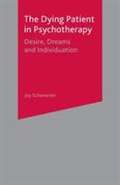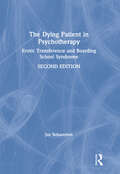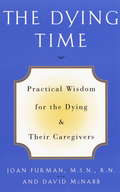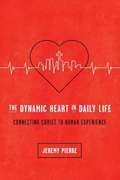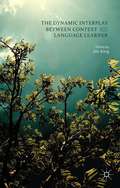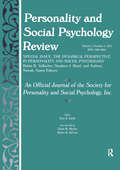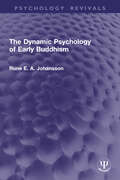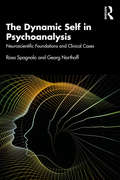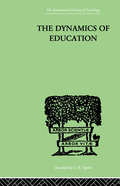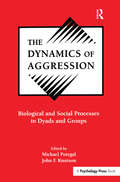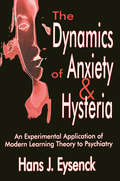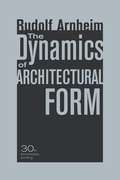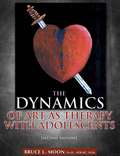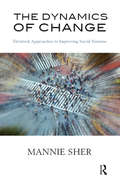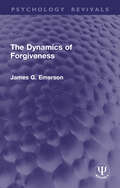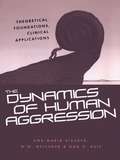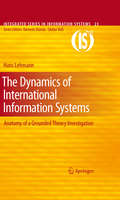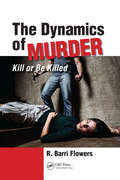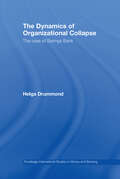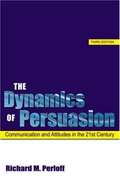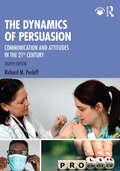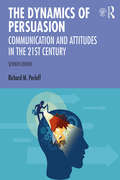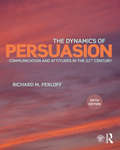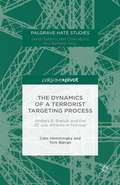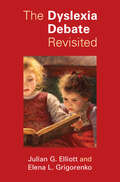- Table View
- List View
The Dying Patient in Psychotherapy: Desire, Dreams and Individuation
by Joy SchaverienThe Dying Patient in Psychotherapy is powerful account of love and death within a therapeutic relationship. The narrative traces one man's journey and that of the analyst who accompanies him. Following on from Joy Schaverien's highly- acclaimed previous books, this full length description of an analysis demonstrates the developmental path of an erotic transference from its origins in infancy, through fantasies of sex and violence, to mature erotic intimacy. The countertransference is considered with exceptional honesty as the analysis intensifies following the diagnosis of a life-threatening illness. A series of dreams, rich in symbolic imagery, traces the psychological situation as death approaches. This book is essential reading for analysts, psychotherapists, counsellors, arts therapists, and all professionals working with the dying. The compelling narrative will also fascinate the general reader. It is practical, theoretical, and imaginative and all, whether expert or new to the subject, will be inspired as the process of individuation is revealed.
The Dying Patient in Psychotherapy: Erotic Transference and Boarding School Syndrome
by Joy SchaverienThe Dying Patient in Psychotherapy is a powerful account of love and death within a psychotherapeutic relationship. The narrative traces one man’s journey in psychotherapy and that of the analyst who accompanies him. The full-length description of an analysis demonstrates the developmental path of an erotic transference from its origins in infancy, through fantasies of sex and violence to mature erotic intimacy. The countertransference is considered with exceptional honesty as the analysis intensifies following the diagnosis of a life-threatening illness. A series of dreams rich in symbolic imagery traces the psychological situation as death approaches. A precursor to Schaverien’s acclaimed book Boarding School Syndrome, the single case study demonstrates the enduring impact of early boarding. This second edition also includes an updated literature review, and new material regarding training and supervision, making it a valuable resource for training institutions. The Dying Patient in Psychotherapy will be essential reading for psychoanalysts, psychotherapists, counsellors, arts therapists and all professionals working with the dying. The poignant story will also engage the general reader, curious about the process of psychotherapy.
The Dying Time
by Joan Furman David Mcnabb"One of the best books available on caring for the dying, The Dying Time combines deep insight and down-to-earth practicality. All caregivers need to know what's between these covers. This book demystifies the process of death, yet honors the sacredness of life's final transition. Highly recommended." Larry Dossey, M.D., author of Prayer Is Good Medicine"Living until we die can be difficult. This book can guide you through that time. It is practical, spiritual, and filled with wisdom."Bernie S. Siegel, M.D., author of Love, Medicine, and MiraclesHere is a comprehensive and thorough handbook for the dying and their caregivers. Joan Furman and David McNabb walk the reader through the dying time, providing details on how to make the environment conducive to peace and tranquillity, give physical care, understand and respond to the emotional and spiritual crises that naturally occur, and stay healthy as a caregiver. They answer with honesty and sensitivity the questions most frequently asked, such as what actually happens at the time of death. The book also deals with arranging for a meaningful memorial service and handling grief for those who are left behind. And it offers guided imagery for coping with pain and suggests literature and music to ease the passage of those whose health is irreversibly failing.From the Trade Paperback edition.
The Dynamic Heart In Daily Life: Connecting Christ To Human Experience
by Jeremy PierreOur hearts are not steel. They are living, complex things that grow and change. Sometimes they fly so high we scrape the top of heaven. Sometimes they barely make it off the ground. Sometimes they feel buried under the ground. What hope do we have of understanding ourselves when we are so changeable? And what hope do we have for lasting change when our response to life is so different from one day to the next? But God designed our hearts to be both varied and varying, and he delights in his craftsmanship. He made our hearts to respond to life in a wide, beautiful spectrum of thought, desire, and choice. This spectrum bends, adapts, expands, and contracts as it dynamically responds to changing situations. The goal of change is not to flatten this variety, but to guide our responses so they reflect who we are in Christ. Jesus perfectly lived his humanity out as a dynamic being. Now as our risen Savior, he redeems all of human experience for his purposes. Without a holistic understanding of people, our approach to those in need of help will be lopsided, focusing on just one aspect of human experienceperhaps simply trying to correct faulty thinking, to stir different emotions, or to correct wrong actions. Focusing on one of these aspects of human experience to the exclusion of the others does not do justice to Gods design. Jeremy Pierre, in this ground-breaking book, lays out a holistic understanding of who we are and how we change through a dynamic relationship with Christ. Every day our dynamic hearts need help from our dynamic Savior.
The Dynamic Interplay between Context and the Language Learner
by Jim KingThis edited volume offers a series of state-of-the-art conceptual papers and empirical research studies which consider how contextual factors at multiple levels dynamically interact with individuals to influence how they go about the complex business of learning and using a second language.
The Dynamic Perspective in Personality and Social Psychology: A Special Issue of personality and Social Psychology Review
by Elitor R. SmithRecent years have witnessed the ascendance of a new way to conceptualize and investigate the nature of dynamism at different levels of psychological reality. Areas of inquiry as diverse as cognitive neuroscience, developmental psychology, organizational behavior, and political sociology are being reframed in terms that allow rigorous and precise insight into basic dynamic processes. There are signs that this new approach to dynamics is emerging as a potentially integrative paradigm for personality and social psychology as well. This special issue highlights this new paradigm and illustrates its relevance to a broad spectrum of topics in personality and social psychology.
The Dynamic Psychology of Early Buddhism (Psychology Revivals)
by Rune JohanssonOriginally published in 1979, The Dynamic Psychology of Early Buddhism was a psychologist’s attempt to understand what the Buddha meant by “dependent origination” (paticcasumappāda, sometimes translated as “causality”). Those who are familiar with Theravada Buddhism have met the famous series of twelve links in the chain of causation (nidanas) of which each is said to be the condition of the next one, and the background of this book is exactly the challenging, teasing incomprehensibility of this series. The author collected all the passages in the Nikāyas or scriptural literature which throw light on the meaning of conditioned sequences, accepting only those explanations which agree with the facts in the Nikāyas. The result of these investigations is that the dynamic aspect of the Buddha’s psychology must have been much more extreme and all-pervading than was usually believed at the time of first publication. Today it can be read in its historical context.
The Dynamic Self in Psychoanalysis: Neuroscientific Foundations and Clinical Cases
by Georg Northoff Rosa SpagnoloThe Dynamic Self in Psychoanalysis builds a bridge between two different but intertwined disciplines—psychoanalysis and neuroscience—by examining the Self and its dynamics at the psychological and neuronal level. Rosa Spagnolo and Georg Northoff seek continuity in the relationship between psychoanalysis and neuroscience, emphasizing how both inform psychotherapy and psychoanalytic treatment and exploring the transformations of the Self that occur during this work. Each chapter presents clinical examples which demonstrate the evolution of the spatiotemporal and affective dimensions of the Self in a variety of psychopathologies. Spagnolo and Northoff analyze the possible use of new neuroscientific findings to improve clinical treatment in psychodynamic therapy and present a spatio-temporal approach that has significant implications for the practice of psychotherapy and for future research. The Dynamic Self in Psychoanalysis will be of great interest to psychoanalysts, psychotherapists, neuroscientists and neuropsychiatrists.
The Dynamics Of Education: A METHODOLOGY OF PROGRESSIVE EDUCATIONAL THOUGHT (International Library Of Psychology)
by Taba, HildaFirst published in 1999. Routledge is an imprint of Taylor & Francis, an informa company.
The Dynamics of Aggression: Biological and Social Processes in Dyads and Groups
by Michael Potegal John F. KnutsonAggression usually involves a sequence of behaviors, reflecting escalations and de-escalations in the form or intensity of the actions taken, which play out over time. This book provides a context in which social and biological research on the aggressive behaviors of human and non-human subjects, interacting in dyads or groups, can be compared and integrated. Implicit in this juxtaposition is the major question of whether general principles governing the dynamics of aggression within and between episodes may be discerned. Aggressive behavior is described at different levels of analysis in humans and a number of other animal species. Three basic views of aggression dynamics become apparent: * The economic interpretation: Aggression will be escalated when it pays one of the combatants to do so or, more generally, when the potential benefits outweigh the risks. Decisions to escalate or de-escalate are part of a calculated "strategy", in one or another sense. This interpretation is formalized within game theoretic models as applied to animal conflicts and to international conflicts, within the chapters of this text. * The psychological process interpretation: Emphasis is placed on psychological/physiological processes within the individual. The chapters stress the importance of acute emotional states of anger and aggressive arousal and argue the role of peripheral sympathetic activation, while proposing a central neural mechanism. Children escalating their tantrums, adult humans and animals of other species intensifying their interpersonal conflicts, national leaders going to a war footing all appear to suffer a narrowing of attention and progressive failure of cognitive function under the intensifying stress of conflict. Perhaps these changes in attention, sensory and cognitive functions, and risk taking reflect a "commitment to aggression" which is necessary for organisms to engage in potentially dangerous and painful encounters. * The emergent process interpretation: Escalation emerges in a spontaneous and dynamic way as the actions of one participant elicit reactions from the other(s).
The Dynamics of Anxiety and Hysteria: An Experimental Application of Modern Learning Theory to Psychiatry
by Hans EysenckHere Hans Eysenck applies the principles of modern learning theory to account for the observed phenomena of hysteria and anxiety. Such principles were initially developed through the experiments and theories of Pavlov, Hull, and Tolman. When The Dynamics of Anxiety and Hysteria initially appeared, these were considered the most advanced, relevant, and applicable to the subject matter. They have not been superseded by later work. The Dynamics of Anxiety and Hysteria has never been published in the United States. It was the fifth book Eysenck authored as part of a series of experimental studies and theoretical work carried out under the auspices of the Institute of Psychiatry at the University of London. Two of the first four books-Dimensions of Personality and The Psychology of Politics, have been reissued with new introductions. These focus on dimensional analysis of personality based on experimental and empirical studies. The present work, on the other hand, goes beyond classification to a study of dynamics; from nosology to aetiology; from description to causation. Eysenck scientifically explores such topics as learning theory and human behavior, personality and learning theory; personality and perceptual processes, socialization and personality, drugs and personality, and psychological theory and psychiatric practice. This volume, which complements Transaction's other new editions of Eysenck's groundbreaking work, will be of lasting significance to psychologists, psychiatrists, behavioralists, and students of personality disorders. He provided for modern psychology the empirical foundations of themes that previosly were the monopoly of psychoanalysis. Hans J. Eysenck (1916-1997), a professor of psychology at the University of London and the director of its psychological department at the Institute of Psychiatry, was best known for his experimental researches in the field of personality. He was a prolific author and wrote, among others, Rebel with a Cause, Dimensions of Personality, and Intelligence, all available from Transaction.
The Dynamics of Architectural Form (30th Anniversary Edition)
by Rudolf ArnheimThe Dynamics of Architectural Form explores the unexpected perceptual consequences of architecture with Arnheim's customary clarity and precision.
The Dynamics of Art As Therapy With Adolescents
by Bruce L. MoonThis new and timely second edition, updated with an expanded discussion of arts-based processes and additional instructions and heartfelt client narratives, continues in the trajectory of the first, promising to shape and provide guidance to both current and next generation of art therapists in the studio-based approach to working with a challenging and often maligned population. It continues to offer much in the way of guidance, motivation, and practical advice around the use of art making as the central curative component when developing therapeutic relationships with hurt and troubled teens. <p><p> The author’s initial focus is on understanding the developmental issues facing adolescents and how these affect the psychotherapeutic treatment. This includes an outline of the phases of therapy: Resistance Phase, Imaging Phase, Immersion Phase, and Letting Go Phase. The second primary focus is devoted to the art as therapy approach to art psychotherapy, with several chapters examining components of this model. The final focus presents the author’s therapeutic approach to working with adolescents through responsive art making. A positive by-product of the book is that the reader will find many practical suggestions regarding materials, artistic tasks, and therapeutic techniques. <p><p> In addition, the text is greatly enhanced by the powerful illustrations that highlight the chapters’ case narratives. This new edition continues to share the author’s essential philosophical, technical, pragmatic, and ethical aspects of practicing art therapy that have made him a standard-bearer for those who believe in the therapeutic power of art. The Dynamics of Art as Therapy with Adolescents should be a cornerstone text for any Adolescent Art Therapy course.
The Dynamics of Change: Tavistock Approaches to Improving Social Systems (Tavistock Approaches To Improving Social Systems Ser.)
by Mannie SherThis book focuses on the hallmark or approaches of the Tavistock Institute—combining research in the social sciences with professional practice in organisational and social change. It shows how consultant and client system are partners in the process of organisational analysis and design.
The Dynamics of Forgiveness (Psychology Revivals)
by James G. EmersonFirst published in 1964, The Dynamics of Forgiveness is the product of a parish and of theological study in the context of a parish. Written by a pastor, it attempts to give enough evidence to establish the place of forgiveness in theological thought, parish life, and personal health. The experiences presented have been subjected to investigation by tested procedures. The author states that he is not a church historian, a systematic theologian, or an authority on human behavior. However, he wished to raise questions for those that are experts in these disciplines and hoped that this book would raise a response.This book is a re-issue originally published in 1964. The language used is a reflection of its era and no offence is meant by the Publishers to any reader by this re-publication.
The Dynamics of Human Aggression: Theoretical Foundations, Clinical Applications
by Ana-Maria Rizzuto W.W. Meissner Dan H. BuieThis book seeks to resolve an issue that has divided psychoanalysts and other scholars of aggression for decades, namely the nature of aggression. The work expands and unifies the Freudian drive-based explanation of aggression into contemporary psychoanalytic theory and practice and brings Freudian theory into the 21st Century.
The Dynamics of International Information Systems
by Hans LehmannWith this new monograph, Hans Lehmann demonstrates the efficacy of using the Grounded Theory method to study the factors that lead to success - or failure - in the creation and ongoing management of the international information systems (IIS) within global enterprises. He presents three cases of large transnational companies he worked with in this study and describes in detail the steps in the analysis of findings and the incremental conceptualization that finally result in a substantive theory of IIS. There is also a companion website that contains a full set of analysis notes to add a further level of detail. Grounded Theory was developed in the social sciences as a means of recording, analyzing, understanding and then fully explaining what was happening within a given social situation - so that theories could be developed that were firmly grounded in those circumstantial facts. The method is very well-suited to solving information systems problems in any enterprise setting, let alone in those situations peculiar to multi-national enterprises.
The Dynamics of Murder: Kill or Be Killed
by R. Barri FlowersIn recent years, there has been a surge in school shootings, workplace homicides, hate violence, and deadly terrorist attacks in the United States. This has resulted in a greater focus on homicidal behavior, its antecedents, ways to recognize warning signs of at-risk victims and offenders, and preventive measures. It has also led to increased effor
The Dynamics of Organizational Collapse: The Case of Barings Bank (Routledge International Studies In Money And Banking Ser. #Vol. 46)
by Helga DrummondThe collapse of Barings Bank was a commercial catastrophe that resonated worldwide, showing what kind of secrets can lie behind an apparently successful organization. Following Nick Leeson‘s arrest and subsequent conviction for fraud, investment banks anxiously reviewed their risk management controls to make sure that it could never happen a
The Dynamics of Persuasion: Communication and Attitudes in the 21st Century
by Richard M. PerloffA textbook revised from the 1993 first edition not only to incorporate events and changes in the technology of communication, but also to focus more on the role theory and research play in persuasion in American society, and the ethical implications of ideas and research. Annotation (c)2003 Book News, Inc., Portland, OR (booknews.com)
The Dynamics of Persuasion: Communication and Attitudes in the 21st Century (Routledge Communication Series)
by Richard M. PerloffThe eighth edition of The Dynamics of Persuasion again guides readers in understanding the power and limits of persuasion in contemporary society. This edition continues its accessible and detailed illustration of the theoretical underpinnings of persuasive communication through contemporary and relevant examples of persuasion in action. It features coverage of new scholarship on misinformation, health communication, and persuasion effects, including careful attention to persuasion’s role in the Covid-19 pandemic. Important issues such as racial injustice, climate change, and barriers to persuading the politically and psychologically polarized also receive a fresh examination. The book brings together classic terms and approaches from earlier editions with new global developments to help readers adopt a more thoughtful perspective on persuasion. The eighth edition is an essential resource for courses in persuasion at the undergraduate and graduate levels within communication studies, psychology, and business programs. Online resources also accompany the text: an Instructor Manual that contains sample syllabi, key terms, chapter outlines, sample discussion questions, and links to relevant news articles and other online resources such as videos; Lecture Slides; and a Testbank. Please visit: www.routledge.com/9781032268187.
The Dynamics of Persuasion: Communication and Attitudes in the Twenty-First Century (Routledge Communication Series)
by Richard M. PerloffNow in its seventh edition, this essential text continues to provide students with a comprehensive yet accessible overview of the study and practice of persuasive communication. Attuned to the swift changes in the world of persuasion in the twenty-first century, this book covers how theories and research illuminate and adapt to our present digital era, with continued attention to ethical implications and today’s big topics. This new edition features updated definitions of key terms in the field as they relate to present-day practice; an integration of persuasion theories and the ubiquity of online influence; new examples and cases to illustrate persuasive communication’s approach to health campaigns, attitudes, communicator appeals, dissonance, and ethics; and a thorough reflection of the most current scholarship in the field. The Dynamics of Persuasion, Seventh Edition provides a solid foundation for undergraduate students in communication studies and psychology to grasp the key concepts and practices of persuasive communication today. The book is complimented by online resources for both instructors and students, including an instructor’s manual, lecture slides, sample test questions, and links to relevant articles and videos illustrating concepts presented in the text. Please visit www.routledge.com/cw/perloff.
The Dynamics of Persuasion: Communication and Attitudes in the Twenty-First Century (Routledge Communication Series)
by Richard M. PerloffThe Dynamics of Persuasion has been a staple resource for teaching persuasion for nearly two decades. Author Richard M. Perloff speaks to students in a style that is engaging and informational, explaining key theories and research as well as providing timely and relevant examples. The companion website includes materials for both students and instructors, expanding the pedagogical utilities and facilitating adoptions. The sixth edition includes: updated theoretical and applied research in a variety of areas, including framing, inoculation, and self-affirmation; new studies of health campaigns; expanded coverage of social media marketing; enhanced discussion of the Elaboration Likelihood Model in light of continued research and new applications to everyday persuasion. The fundamentals of the book – emphasis on theory, clear-cut explanation of findings, in-depth discussion of persuasion processes and effects, and easy-to-follow real-world applications – continue in the sixth edition.
The Dynamics of a Terrorist Targeting Process: Anders B. Breivik and the 22 July Attacks in Norway (Palgrave Hate Studies)
by Tore Bjørgo Cato HemmingbyThis book provides an in-depth analysis of probably the most horrific solo terrorist operation the world has ever seen. On 22 July 2011 Anders Behring Breivik killed 77 people when he bombed the Government District in Oslo, before he conducted a shooting attack against a political youth camp at Utøya. The main focus of the book is on the operational aspects of the events, particularly the target selection and decision-making process. Why did Breivik choose the targets he finally attacked, what influenced his decision-making and how did he do it? Using unique source material, providing details never published before, the authors accurately explain how even this ruthless terrorist acted under a number of constraints in a profoundly dynamic process. This momentous work is a must read for scholars, students and practitioners within law enforcement, intelligence, security and terrorism studies.
The Dyslexia Debate Revisited
by Julian G. Elliott Elena L. GrigorenkoIn every country, and in every language, a significant proportion of children struggle to master the skill of reading. In 2014, The Dyslexia Debate examined the problematic interpretation of the term 'dyslexia' as well as questioning its efficacy as a diagnosis. Ten years on, The Dyslexia Debate Revisited reflects on the changes in dyslexia assessment and treatment over the last decade, including the introduction of dyslexia legislation in many US states. Addressing the critical responses to their original challenge of the dyslexia construct, Julian G. Elliott and Elena L. Grigorenko also consider why, despite scientific critiques, existing dyslexia conceptions and assessment practices continue to be highly attractive to many professionals, individuals, and families. Based on current scientific knowledge, the authors strive to promote a shared understanding of reading difficulties and emphasize the importance of providing timely and appropriate intervention and support to anyone who faces difficulties with learning to read.
